Musica Nova and Private Style
Many of the poems set in Willaert's anthologized corpus must have been written by professional polygraphs styling themselves after the prototypes of Franco and Doni, or else by courtier-academists like Spira, Muzio, or Dolce. These new eclectics abounded in the commercializing culture of sixteenth-century Venice, transforming Petrarchan tropes and reworking Petrarch's lyric meditations into the speeches of real-life lovers. The amorous pleas of Quanto più m'arde and pointed diatribes of Rompi dell'empio cor or Sciocco fu 'l tuo desire exemplify the immediacy such verse offered over standard Petrarchan lyrics, even over the shorter canzone stanzas by Petrarch that Willaert anthologized. Still, those canzoni stanzas, alleviated by an admixture of settenari and structurally similar to cinquecento poetic madrigals, offered some relief from the weightiness of Petrarch's ponderous sonnets. Of the anthologized madrigals only seven are sonnet settings and of these Willaert only divided two into two parts. None of the sonnets' authors is known; indeed, only three poets apart from Petrarch can as yet be named for any of Willaert's anthologized settings.
Standing wholly apart from these is the remarkable collection that apparently went so little seen for nearly two decades until it was finally printed with the title Musica nova. Nothing distinguishes the two repertories more than the absence of even a single sonnet by Petrarch among the miscellanea as compared with twenty-four settings of Petrarch's sonnets in the Musica nova, all of which Willaert divided into two parts after the manner of the contemporary motet.
The Musica nova owed its unique complexion to a symbiosis of musical and literary interests that transcends our usual notions of conscientious text setting. Inspired by the wave of Ciceronianism in current literary theory, the madrigals in the collection presented themselves as self-conscious exemplars of a high, serious style. They formed an explicitly secular counterpart to Musica nova's motets (which they followed physically in the print) by their division into two parts, their austerity, the inclusion of four-, five-, six-, and seven-voice settings (like the motets), and the searching nature of their poems. The juxtaposition of Petrarch's sonnets with many motet texts drawn from the Old Testament and dealing with issues of sin and penitence further reinforced the madrigals' parity with the motets.[41]
If the tonal makeup of the four- and seven-voice pieces is any indication, Willaert may have had a direct hand in the structural paralleling of sacred and secular, for motets and madrigals share a partial identity and order that can be seen by comparing Tables 4a and 4b. These tables list what Harold S. Powers has called the "tonal types" employed for the works in each genre, including signatures (or "systems"), cleffings, and finals.[42] Those of the four-voice motets are identical to the four-voice madrigals, with only a minor exception in the inner-voice cleffings of the fourth
[41] See Willaert, Opera omnia 5:iv.
[42] See "Tonal Types and Modal Categories in Renaissance Polyphony," JAMS 34 (1981): 428-70.
| ||||||||||||||||||||||||||||||||||||||||||||||||||||||||||||||||||||||||||||||||||||||||||||||||||||||||||||||||||||||||||||||||||||||||||||||||||||||
pair, while the seven-voice works (including the last four of the five seven-voice motets) are identical except for the signatures in the penultimate pair. Notwithstanding these differences, it is hard to see how such a sequentially ordered pattern of triadic correlations (i.e., system-cleffing-final) could have arisen by coincidence.[43] They raise at least two possibilities: first, that the correspondences between what are mostly unusual tonal types occurred because the paired madrigals
| ||||||||||||||||||||||||||||||||||||||||||||||||||||||||||||||||||||||||||||||||||||||||||||||||||||||||||||||||||||||||||||||||||||||||||||
and motets were to be performed by identical forces in a single venue when they first came into being; and second, that Willaert may even have originally considered planning the madrigal and motet sections as tonal-timbral mirrors of one another. Even though evidence to establish the second of these is lacking, it is useful to recognize that by extending other parallelisms in the collection, such an arrangement would have substantially strengthened the collection's implicit Bembist assertion
that the two categories, sacred and secular, Latin and vernacular, could stand on an equal footing.
Willaert heightened the madrigalistic genre not primarily in these four- and seven-voice works, however; the four-voice works represent the least complex essays in the new style, and the seven-voice works are dialogues that typically pit three- and four-voice groups against one another in large-scale, often homophonic alternations. Instead, the collection is dominated by the madrigals for five and six voices, which incarnated the style at its most sober and introspective and posed the most challenging alternative to preexisting madrigalian norms. Verdelot's five- and six-voice predecessors had shown no signs of pushing the genre toward such a thoroughly polyphonic state. If anything, Willaert's resembled more the continuous, thick polyphony of Gombert's motets, the banderole of post-Josquin international polyphony.
Yet Willaert's idiom differed from both Verdelot's and Gombert's in taking its cue to a far greater extent than either of them did from the words. His settings consistently articulated syntactic structures with musical structure and rhetorical nuances with musical gestures and textures. In accomplishing this in the general "dialect" of the motet, Willaert's Musica nova madrigals participated in the larger project of elevating the vernacular. Now the singing of Italian lyrics could claim a universal significance parallel to the motet's.
This goes far toward explaining what made the sonnet Willaert's ideal vehicle. Sonnets carried rhetorical weight without overwhelming size and naturally invited bipartite division. As a formal genre and one of the most fixed of lyric forms, the sonnet had served as the traditional lyric vehicle for expressing archetypal states of emotion.[44] Literary theorists like Bembo, Ruscelli, and Tasso repeatedly noted that an inevitable corollary of the sonnet's distantly spaced rhymes and long lines (its suono and numero ) was an intrinsic gravità. Within such obdurate matrices as these, poets could impose temporal order on a wide-ranging conceptual space.
Venetian composers found numerous possibilities for musical interpretation of the many temporal-formal schemes that sonnets offered. In the following pages I explore this idea in connection with Petrarch's Pien d'un vago pensier che me desvia. Among sonnets set by Willaert, Pien d'un vago pensier typifies one of the genre's essential strategies, that of locating a spiritual journey within fixed boundaries and demarcating its progress at a series of structurally articulated stages.[45]
[44] See Christoph Kleinhenz, "The Art of the Sonnet," in Francis Petrarch, Six Centuries Later: A Symposium, ed. Aldo Scaglione, North Carolina Studies in the Romance Languages and Literature, Symposia, no. 3 (Chapel Hill and Chicago, 1975), esp. p. 190.
[45] For discussions related to this kind of temporal structuring see Fredi Chiappelli, "An Analysis of Structuration in Petrarch's Poetry," in Francis Petrarch, Six Centuries Later, ed. Scaglione, pp. 105-16; and (more specifically on temporal order in the sonnet) Kleinhenz, "The Art of the Sonnet," ibid., pp. 177-91.
The lyric development I describe is completely undone in Bernardino Tomitano's inversion and rewriting of the sonnet's parts-vv. 1-8 as 8-1 and 9-14 as 14-9 — in a poem included in Rime de' piu illustri poeti italiani scelte dall'abbate Antonini. Parte prima, ed. Annibale Antonini (Paris, 1731), fol. O v', no. 166.
Pien d'un vago pensier che me desvia Full of a yearning thought that makes me stray away
Da tutti gli altri, e fammi al mondo ir solo, From all others and go alone in the world,
Ad hor ad hor a me stesso m'involo, From time to time I steal myself away from myself,
Pur lei cercando che fuggir devria; Still seeking her whom I should flee; 4
E veggiola passar sì dolce e ria And I see her pass so sweet and cruel
Che l'alma trema per levarsi a volo, That my soul trembles to rise in flight,
Tal d'armati sospir conduce stuolo Such a crowd of armed sighs she leads,
Questa bella d'Amor nemica e mia. This lovely enemy of Love and me. 8
Ben, s'io non erro, di pietate un raggio Surely, if I err not, I do discern a ray
Scorgo fra 'l nubiloso altero ciglio, Of pity on her cloudy, proud brow,
Che 'n parte rasserena il cor doglioso: Which partly clears my grieving heart: 11
Allhor raccolgo l'alma, e poi ch'i aggio Then I collect my soul and when I have
Di scovrirle il mio mal preso consiglio, Decided to discover to her my ill-taken counsel,
Tanto le hò a dir che 'ncominciar non oso. I have so much to say to her that I dare not start.[46] 14
Petrarch begins with fantasy, his most fluid medium of movement. The kinetic force that governs this movement is the "vago pensier," the elusive thought that never finds satisfaction in its own self-expression. Steadily the poet moves through a series of unbounded spatial zones. Pulled in turn from the world, from himself, and toward Laura, his soul threatens to take flight, only to be regained unfulfilled. In the end he circles back to his starting point — love unexpressed. Lack of fulfillment and the continual, billowing movement it generates are thus the beginning and end of the poem and the driving impulse throughout.
Successively Petrarch aligns this series of plastic states with the sonnet's compositional structure, matching the migrations of the poet's soul with its four main sections. The first couplet removes him from the world at large to a state of solitude, while the next one rounds off the quatrain with the poet's flight from himself and quest for the beloved. The second quatrain flirts with a potential but frustrated flight of the spirit — a fantasy within the fantasy as he imagines his beloved. In the first tercet the poet hesitantly takes heart from the lady's pity, her half-lucid brow half-clearing his heavy heart. Encouraged, he braces himself to regain his soul ("raccolgo l'alma") in the last tercet — though, predictably, to no avail. These migrations are strung together with enough semantic instability and syntactic fluidity to yield a nearly continual sense of motion. Petrarch's real theme is a spiritual ebbing and flowing, a swaying of the mind. Such psychic movement is the underlying theme of the Canzoniere, a series of internal fluxes that never fully comes to rest and continually refers back to itself. Since the motion is constant, however, it is also static, forever circling with no intended destination but its own self-created world.
[46] Here and below I have taken the liberty of adapting and arranging in verse lines Robert M. Durling's translations of Petrarch's sonnets, Petrarch's Lyric Poems: The "Rime sparse" and Other Lyrics (Cambridge, Mass., 1976). His translations have been invaluable to my work.
Willaert's sacred idiom, with its long-breathed lines constantly overlapping in subtly varied guises and its continual changes of textures and timbres, must have found close company in Petrarch's poetics. Through a continuous, unstable polyphonic web, it realized the meandering syntax Petrarch often utilized to embody his themes of spiritual uncertainty, evoking in musical abstractions effects parallel to Petrarch's verbal ones. (For the complete score see Ex. 14.) Indeed, Willaert set Pien d'un vago pensier without a single notable cadential break except for the one that divides the two parts. The few cadences that occur are so thickly buried in artful counterpoint that they pose little threat to the madrigal's general continuity. Tension is created through constant gesturing toward resolution and turning away, gesturing that recalls Zarlino's descriptions of evaded and extravagant cadences.
Willaert created this kind of polyphony by manipulating the blandest of melodic materials. His melodies largely move in conjunct paths and most of the motives are so mildly profiled as to be almost indistinct from one another. The imitations are generally loose because motivic variation frees up each voice for an independent recitation of the words. Frequently Willaert's melodies move along in chains of minims or alternate unremarkably between minims and semibreves. His soggetti tend to reinforce such regularities, falling out in binary repeated-note groups (as in the opening measures). With few exceptions, the composite declamatory unit holds resolutely to the minim. Most important, this relentlessly even declamation is predicated on a syllabic delivery of the words, with melismas placed few and far between.
Like plainchant, Willaert's declamation and parsing of verse make it seem almost like spoken text, with a resulting emphasis on asymmetrical linear and grammatical constructions. (Notice the localized syntactic articulation given the text at the beginning of the seconda parte. ) Through these various musical techniques, Pien d'un vago pensier (like other madrigals in the Musica nova ) emerges as a subdued musical counterpart of the decorum advocated by Venetian literati and statesmen.
At the same time, the madrigal develops its own musical version of the Bembists' corollary of variazione through its use of constantly shifting materials and forms. The principle of variazione manifests itself most clearly in the changing motivic shapes and accents assigned to different segments of the text. Willaert's preoccupation with diction meant that all the different versions declaimed (soggetti and their variations) had to contain equally accurate patterns of accentuation but not the same rhythmic profile, and the actual pitch content of different statements often seems almost immaterial. Thus, although the same syllables may be stressed in each statement of a textual fragment, the means of accentuation generally differ. Measures 93-103, for example, encompass disparate, overlapping versions of v. II in altus, cantus, and quintus. Willaert renders the third syllable of "rasserena" — the sixth of the endecasillabo and the line's chief poetic accent — in three different ways, each equally suited to the poem's prosody: the altus places -re - on the tactus in a lengthy dotted semibreve (m. 95); the cantus syncopates it on a semibreve (m. 96);
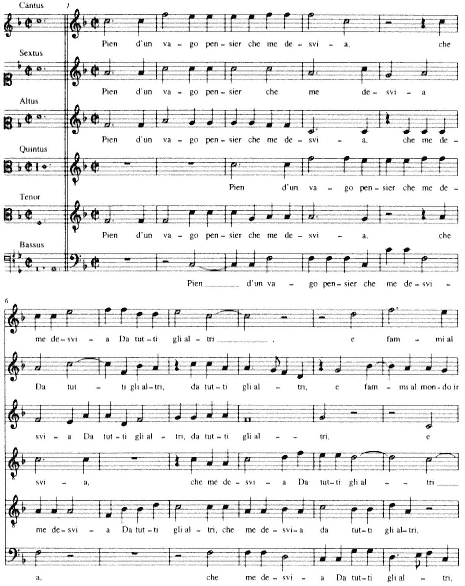
Ex. 14.
Willaert, Pien d'un vago pensier che me desvia (Petrarch, no. 169), incl.;
Musica nova (Venice, 1559), no. 21.
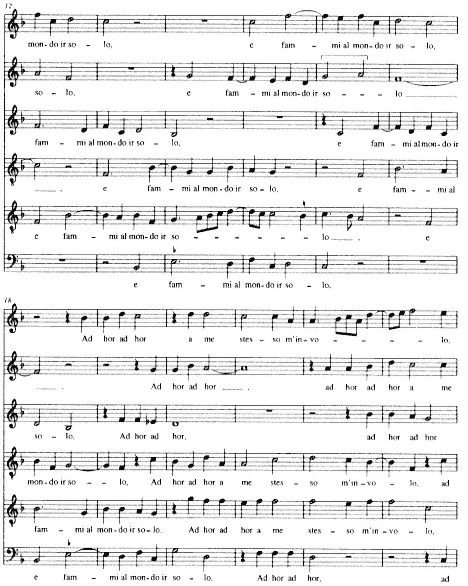
Ex. 14
(continued)
(continued on next page)
(continued from previous page)
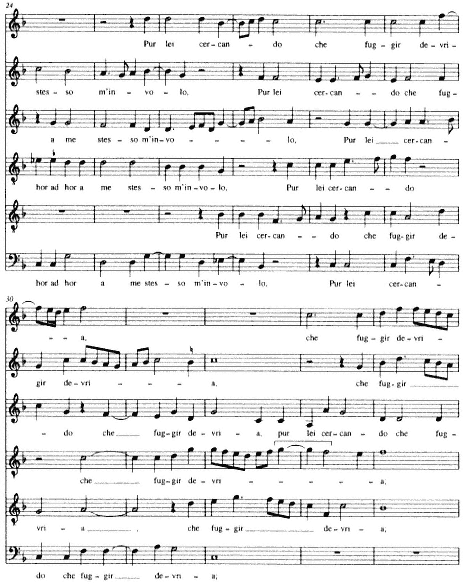
Ex. 14
(continued)
(continued on next page)
(continued from previous page)
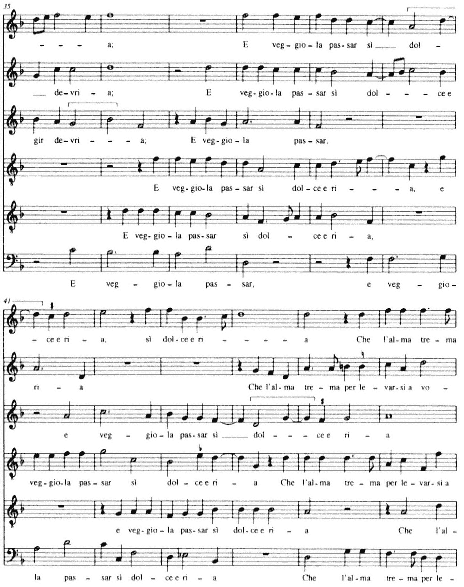
Ex. 14
(continued)
(continued on next page)
(continued from previous page)
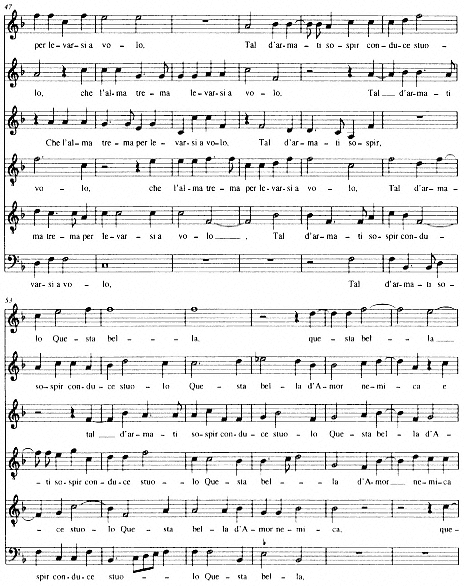
Ex. 14
(continued)
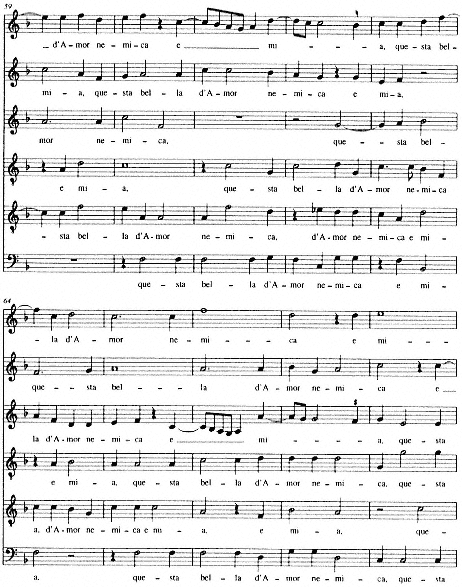
Ex. 14
(continued)
(continued)
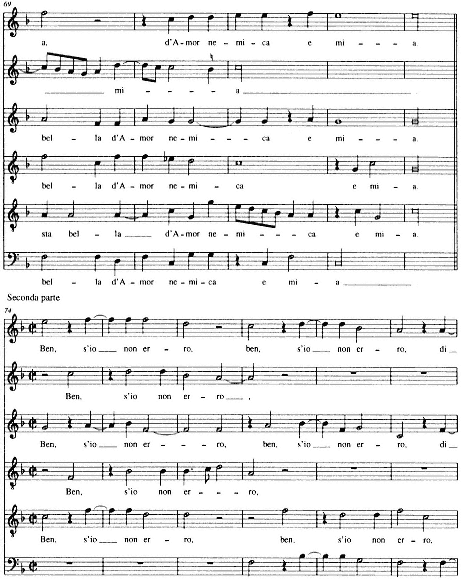
Ex. 14
(continued)
(continued)
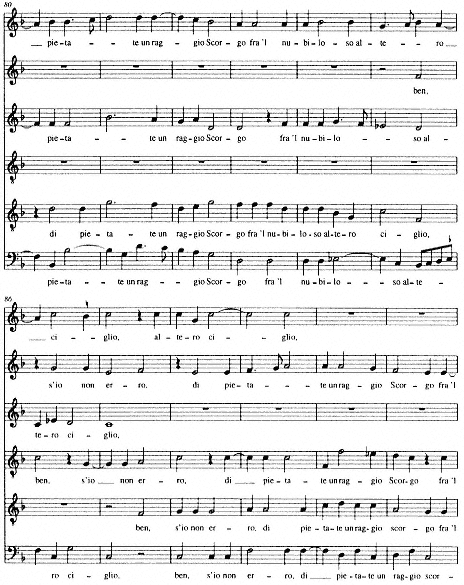
Ex. 14
(continued)
(continued)
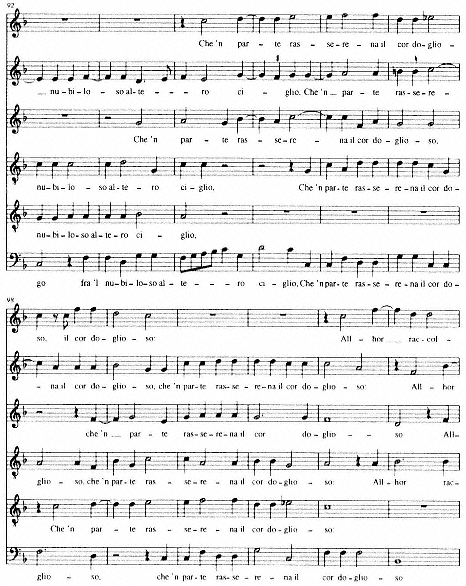
Ex. 14
(continued)
(continued)
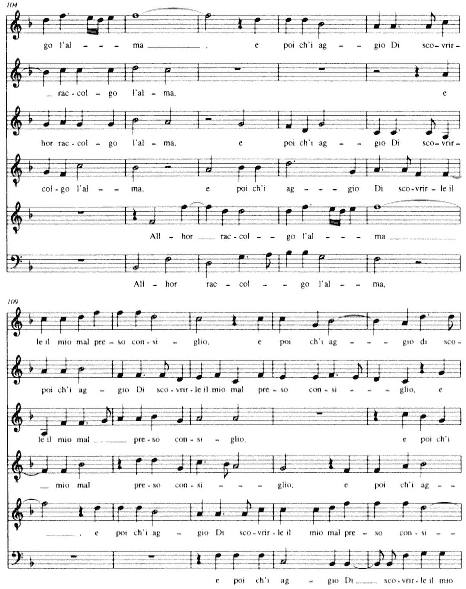
Ex. 14
(continued)
(continued)
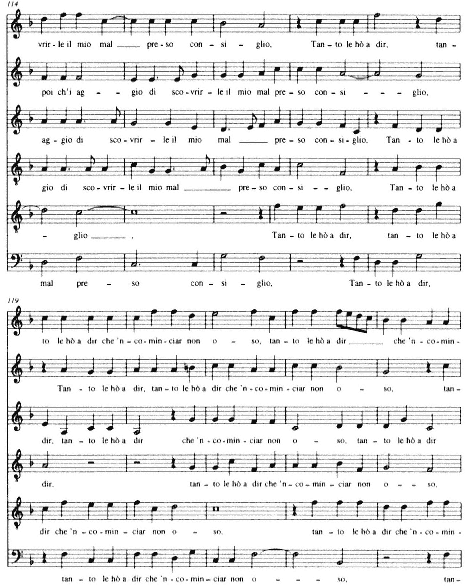
Ex. 14
(continued)
(continued)
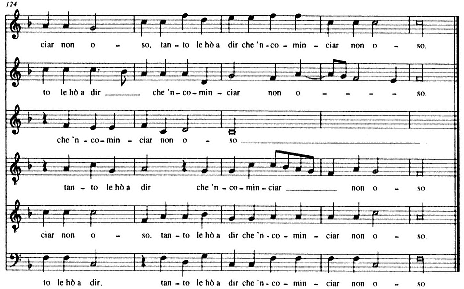
Ex. 14
and the quintus returns it to the tactus with a ubiquitous double-minim figure (m. 97). Both altus and cantus apply agogic accent — prolongation — while the quintus relies wholly on the always unambiguous tonic accent. (A comparable kind of variety obtains with the secondary accent, par - of "parte" near the beginning of the line.) The combined effect of this technique is a lack of any unified polyphonic assertion of meter. In its place a constantly shifting metric polyphony coalesces — faint in its overall level of stress, but pulsating with gentle, inexorable uniformity in the background.
Only on rare occasions, when striking sounds or rhythms appear in the verse, did Willaert project text with a single rhythmic gesture. By contrast with the foregoing, for instance, witness in Ex. 15 the relatively consistent way he set "e rompr'ogn'aspro scoglio" (v. 6 from the five-voice Giunto m'ha Amor fra belle e crude braccia ), with its coarse mouthfuls of r 's, double and triple consonantal clusters, and sonorous a 's and o 's.[47]
This avoidance of clear motivic and metric definition has a parallel in Willaert's cultivation of variegated textures. As successive combinations of freely overlapping voices roam alternately toward homophonic or imitative poles, the various parts constantly rearrange themselves in new configurations. And since every evolving configuration brings with it a new combination of voices, Willaert's vocal color takes on the look of an ever-turning kaleidoscope.[48]
[47] See also the setting of "Romper le pietre," mm. 98ff. from Mentre che 'l cor.
[48] Jonathan Marcus Miller extends my work on Willaert and Rore to argue that both composers constructed their textures in such a way as to bring out clusters of sound, which were in turn designed to help project textual meaning; see "Word-Sound and Musical Texture in the Mid-Sixteenth-Century Venetian Madrigal" (Ph.D. diss., University of North Carolina at Chapel Hill, 1991).
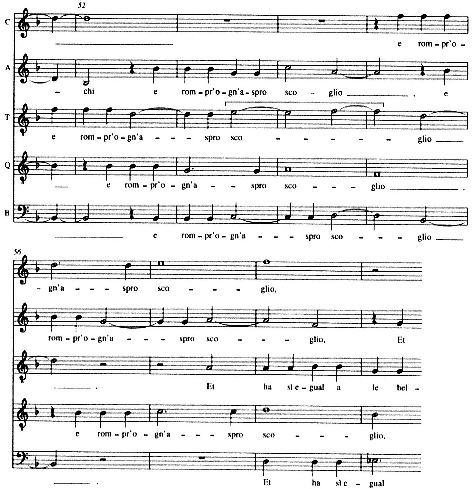
Ex. 15.
Willaert, Giunto m'ha Amor fra belle e crude braccia (Petrarch, no. 171), mm.
52-59; Musica nova (Venice, 1559), no. 11.
These kaleidoscopic effects do not diminish Willaert's ability to shape Petrarch's conceptual patterning in music, as the structural summary of Pien d'un vago pensier in Table 5 makes plain. The schemata of Table 5 necessarily give only a crude picture of the real articulative events in the piece, since the cadences, while intelligible contrapuntally as two-voice formations, are almost always obscured and enervated by the surrounding polyphonic activity of the other voices. Note, for example, that the first cadence, to the perfect octave c/C in tenor and bassus in m. 16, is thoroughly overlapped by multiple, varied assertions of the motive on "e fammi al mondo ir solo" throughout the upper registers. However clear-cut such a two-voice cadence may be, the overall impression conveyed is one of continuity. In a texture like this one, fine gradations in articulation can be projected through the relative strength of preparation and resolution. But such preparation and resolution are rarely unequivocal except at
| ||||||||||||||||||||||||||||||||||||||||||||||||||||||||||||||||||||||||||||||||||||||||||||||||||||||||||||||||||||||||||||||
the end of the prima or seconda parte or at exceptional rhetorical moments and, in any case, are always complicated by other factors — especially texture.
The next cadential gesture at the end of v. 3 (mm. 22-23) presents a different situation, related to the ubiquitous technique that Zarlino dubbed "fuggir la cadenza." The cadence is conspicuously prepared but its resolution is foiled as it moves from an intended penultimate sonority on a C-major triad to one on c-minor. The cadential cantus falls silent at its expected moment of arrival on ff at m. 24 (one of Zarlino's standard "evasion" techniques), replaced by a jarring cross relation, ee/e-flat, with the quintus.
Despite this constant undercutting, Willaert's complex cadential formations do not hinder the goal of supporting Petrarch's linguistic and thematic articulations.
Quite the contrary; they aid it by complementing Petrarch's verbal hierarchy with a musical one, at least within the subtle band of utterance Willaert's idiom allows. Willaert's Musica nova settings generally vary the degree to which cadences are made strong or weak through a judicious deployment of perfect and imperfect cadences, extravagant cadences, different sorts of evasions, and rests. In Pien d'un vago pensier Willaert varied articulative weight, modifying the number of cadential gestures successively deployed by shifting voice pairs for a given portion of text. Mild but calculated cadential repetition is key to such a strategy. By means of sheer repetition, Willaert strengthened the conclusions of each of the independent clauses that end the two quatrains (mm. 30, 32, 34, and 36; mm. 63, 68, 71, and 73) — even though the gestures taken singly are not especially strong — and in accordance with Zarlino's dictum that textual repetitions be limited to significant parts of a text. Cadences are also positioned carefully in different tessituras according to grammatical weight. Thus while the lower voices bury their cadence under continuous upper-voice melody when ending a mere dependent clause at m. 16, three of the four cadences that end the main clause of the first quatrain are exposed in the uppermost register (mm. 30-36).
Verse 12 shows how shrewdly Willaert coordinates these articulations with the main structural divisions of the sonnet. At this juncture, two striking cadences demarcate the poet's progress following the rhetorically crucial "Allor raccolgo I'alma." Though standing in formal isolation, prosodically unhinged, these words signal the poem's spiritual turning point. Willaert's setting highlights them with an independent melody and a turn to somewhat broadened rhythmic gestures. As the declamation slows, the semibreves allow the resonant a 's, o 's, and the double consonants to breathe, creating assonance in accented and unaccented syllables alike and a deceleration that marks at once the text's grammatical structure and its "grave" rhetorical character.[49]
The value of Willaert's reading is both immediate and contextual, since it sets up the musico-dramatic pacing of the remainder of the sonnet. The long phrases subsequently assigned to "e poi ch'i aggio / Di scovrirle il mio mal preso consiglio" (vv. 12-13) in order to span the enjambment contrast with the relatively short ones that have just been heard. Further, by returning to a predominant minim motion, the music resumes its insistent pace and starts to marshall the more bustling texture with which Willaert generally approached sectional endings. Willaert sustains both qualities through the final verse and heightens their rhetorical effects with a flood of closely spaced entrances for "Tanto le ho à dir," a new voice entering nearly every semibreve from mm. 116 to 123.
Willaert's organization of cadences supports these subtle interactions of meaning and prosody as much as it does grammatical weight. To consider how this operates,
[49] Willaert generally used this technique to distinguish the articulations between quatrains and tercets. See, for instance, the transitions from vv. 4-5 in L'aura mia sacra (m. 49) and Giunto m'ha Amor (mm. 39-40); and from vv. 11-12 in L'aura mia sacra (mm. 92-93) and Cantai, hor piango (mm. 96-97); Willaert, Opera omnia, vol. 13.
let us assume (with Zarlino) that a background modal conception underlies the madrigal's overall pitch plan. Zarlino assigned Pien d'un vago pensier to mode 11,[50] transposed Ionian authentic as conceived within Glareanus's twelve-mode numbering system, or mode 5 (authentic Lydian) in the traditional eight-mode system. Cantus, tenor, and quintus are all in authentic ranges, sextus, altus, and bassus in plagal. Willaert's setting concentrates cadences on the primary cadential degrees of the mode, the final F and confinal c. As shown in Table 5, the dependent clause of vv. 1-2 moves to the confinal, while three of the cadences ending the main clause in v. 4 (mm. 30, 34, and 36) form cadences on the final (albeit enfeebled by lower voices moving to the secondary degrees a, b-flat, and dd, respectively). In this mode all theorists of modal polyphony ranked the medial a just below the final and confinal in terms of cadential weight, and most named E, D, G, and b-flat as secondary degrees, permissible for internal cadences.[51] The remainder of the prima parte constructs a neat bit of tonal architecture, with a supporting the main clause that begins the second quatrain (m. 46) and a series of cadences emphasizing the final's antipole of C in the approach and conclusion of the octave. Not until the clause "Allor raccolgo l'alma" returns in v. 12 does Willaert cadence again on the final, and there he does so twice — once on the fifth ff/b-flat (m. 105), next on a perfect octave, f/F (m. 108).
Yet the point should be made again that none of these cadences comes close to halting or delaying the ongoing polyphonic motion. As a result of this continuity, everything takes place within a general gestalt of sameness, a contrapuntal feature of all Musica nova madrigals but a particular tonal characteristic of those in F-mollis. As if dabbing on empty canvases Willaert brightened them only with the lightest coloristic touches, in bursts like firefly shimmer, to conjure up vivid local moments.
Pitch color thus manages — and is managed by means of — two basic strategies: one involves choosing pitches gauged to help bring out hierarchic interrelationships of poetic syntax; the other involves accommodating the exigencies of these syntactic concerns to the subdued demeanor of the whole collection. At the local level of coloristic events Willaert pits relative stability against instability toward expressive ends, just as he does at the more architectonic level of cadential design. Just before restoring the final F in v. 12, for example, he presses B-flats and E-flats plaintively on the "cor doglioso" of the relative clause in v. 11. This turn to the flat side easily catches the ear, despite its mildness, because Willaert uses it only rarely. (Another set of E-flat inflections [mm. 19 and 24] follows the self-exodus narrated in v. 3, "Ad hor ad hor a me stesso m'involo.")
Flatted inflections often participate in larger processes of stabilization and destabilization that are regulated by Willaert's frequent use of circles of fifths. The preva-
[50] Istitutioni harmoniche, p. 333.
[51] For a summary of theorists' writings on this matter, see Bernhard Meier, The Modes of Classical Vocal Polyphony Described according to the Sources, trans. Ellen S. Beebe, rev. ed. (New York, 1988), pp. 101-22 (and for discussion of the cadence plan of a work by Wert in the same mode, pp. 158ff.).
lence of circle-of-fifth progressions offsets the potential that the melodies and counterpoint might be enervated by a certain aimlessness. In the passage just discussed, Willaert explores the flat side within fifth progressions in a way that reinforces poetic motion toward the syntactic/rhetorical goal: the E-flat triad of m. 18 moves backward through a circle of fifths all the way to one on a-minor (m. 21); and a briefer circle of fifths from a B-flat-major triad to one on d-minor (mm. 23-25) overarches the false resolution of the C-major sonority to c-minor.[52] This regulation of the flat side through the strong harmonic directedness of fifth progressions allows Willaert to convey the text in a way that appeals directly to the senses, instead of simply matching the poet's flight in a purely formal or iconic way.
Some of these circles of fifths do not project verbal meaning directly but simply help propel the counterpoint toward an imminent syntactic goal. In mm. 120-22, for instance, Willaert intensifies the repetitions of "tanto le ho a dir" by means of a fifth progression from a d-minor triad to one on B-flat. This is only the longest of several sequences of fifths that help strengthen the drive toward the final cadence (cf. mm. 114-16 and 125-26). In tonally static madrigals like this one, which oscillate along an F-C axis with little real movement toward an alternate tonal target, the sense of harmonic direction provides a vital source of kinetic energy.[53]
Willaert's coloristic techniques play another role in subtly resolving local syntactic ambiguities. To understand the interaction of tonal color and syntax at this local level, one needs to consider how Willaert copes with Petrarch's complex verbal constructions. Invariably, Musica nova settings parse words as prose rather than as verse, ostensibly linking proselike readings with dignity and gravity in the same way literary theorists like Daniello and Tomitano did in advocating proselike syntax for poets writing high lyric verse.[54] In these madrigals the juncture between words and music had thus fully shifted from the poetic line to the syntactic unit. As noted earlier, this meant that the enjambments favored by literati for sonnets ran rampant in Venetians' musical phrasings,[55] causing the textual units to fall out in unpoetic and highly asymmetrical arrangements.
Even this rule of thumb could not produce all the necessary solutions about how to parse a given text, however, since not all verbal constructions unequivocally suggested a single prose reading. Indeed, Pien d'un vago pensier includes one of the most ambiguous, Latinate lines Petrarch ever wrote, v. 8: "Questa bella d'Amor
[52] Cf. also the circle of fifths from the end of m. 96 to m. 98.
[53] Gary Tomlinson has noted this phenomenon as part of the pastoral topos employed by Wert, Marenzio, and Monteverdi, in Monteverdi and the End of the Renaissance (Berkeley and Los Angeles, 1987); see also Chap. 8 below, nn. 24 and 25.
[54] See Chap. 5 above, nn. 122 and 133.
[55] In addition to the comments on enjambment cited in Chap. 5 above, nn. 142-44, see also Torquato Tasso's praise of Giovanni della Casa's use of the technique in his "Lezione sopra Questa mortal vita, " discussed in Gary Tomlinson, "Rinuccini, Peri, Monteverdi, and the Humanist Heritage of Opera" (Ph.D. diss., University of California at Berkeley, 1979), pp. 55-57.
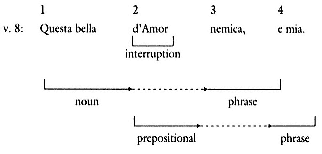
Fig. 1A
nemica, e mia."[56] Structurally, this is a line that evokes the mercurial quality of Petrarch's elusive lady. It rends the Petrarchan oxymoron on the beloved, the "bella nemica," with the intrusive "d'Amor" to form four disconnected grammatical units, as shown in Fig. 1a. Here the four constituents stand in a kind of chiastic relationship to one another, each of them one position removed from its proper neighbor. But the elements can also be considered in another way, as suggested in Fig. 1b. In this reading "questa bella" forms a complete and independent substantive, if a disarmingly casual one in Petrarchan discourse for reference to Laura. "Nemica" then counts as a second noun phrase troping "questa bella," and "d'Amor" a prepositional phrase defining simply "nemica." The possessive "mia," free-floating outside the main frame of the line, might be thought to define either "bella" or "nemica," or both, depending on how the reader perceives the line; its indeterminacy proceeds from the vagueness of the substantive, without which "mia" has no point of reference. Since Petrarchan commentators of Willaert's time seem consistently to have read the line as in Fig. 1a (as we will see Willaert appears to have done also), it seems fair to take this as our point of departure.[57]
The severed noun phrase of line 8 surprises, since even Petrarch's mannered norms did not usually allow for it. But the ambiguities thus created are a vital part of the line's rhetorical effect and its meaning. "Amor" is not only the intruder in the syntactic process but the culprit in the fractious vision of the poem as a whole. As hinted above, the witty dissociation of "e mia," combined with the line's lack of an unambiguous substantive, robs it of a clear grammatical affiliation and hence mean-
[56] For a fuller discussion of Willaert's syntactic strategies see my "Composer as Exegete: Interpretations of Petrarchan Syntax in the Venetian Madrigal," Studi musicali 18 (1989): 203-38, of which pp. 212-16 have been adapted for what follows. A broader appraisal of medieval and Renaissance concepts of syntax may be found in W. Keith Percival, "Deep and Surface Structure Concepts in Renaissance and Medieval Syntactic Theory," in History of Linguistic Thought and Contemporary Linguistics, ed. Herman Parret (Berlin and New York, 1976), pp. 238-53.
[57] Sixteenth-century commentators tended to restore the oxymoron with the paraphrase "Questa bella nemica d'Amor, e mia," with no comma after "bella" that would designate it a noun. See, for example, Sonetti, canzoni, e triomphi di Messer Francesco Petrarca con la spositione di Bernardino Daniello da Lucca (Venice, 1541), fol. 113; and Le rime del Petrarca brevemente sposte per Lodovico Castelvetro . . . (Basel, 1582), p. 312.
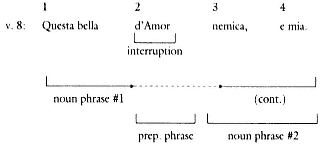
Fig. 1B
ing (my lovely one? my lovely enemy? mine and Love's?). The disorientation of "mia" comments on the slippery nature of the thing possessed; yet its dangling isolation, a structural means of semantic emphasis, accentuates at the same time the quality of possession.
Given Willaert's concern for linguistic coherence the line presented declamatory problems and perhaps inevitably invited multiple, fragmentary readings.[58] By offering a number of different fragments of the line Willaert was able to comment both on the nature of the fragmentation and on the grammatical interrelationships of the verse. Much of it he parsed in such a way as to unify the noun phrase "questa bella nemica": two outer voices initially present "questa bella" alone with a separate, lingering melodic figure, but immediately afterward all six declaim the verse in integral phrases up to the word "nemica." This bit of text, the one most frequently stated, fuses in a single melodic gesture the subject "nemica" with its qualifying adjective "bella." We might say that Willaert admitted the ambiguity and then resolved it: "Questa bella . . .," "Questa bella d'Amor nemica. "
In the tenor, by contrast, beginning in m. 62, Willaert linked the other disjointed verbal elements indicated in Fig. 1a by deploying a different textual fragment: "d'Amor nemica, e mia." This is the only time in this lengthy exposition when "e mia" joins directly any other portion of the verse, and the reason for it seems clear. Without the suspended adjectives "questa bella," no consolidation of the noun phrase (as obtained by ending with the word "nemica") is required. The phrase "d'Amor nemica, e mia" instead serves to unify words that function in essence as two prepositional phrases: "d'Amor" and "e mia" (that is, "d'Amor, e di me"). Now, for the only time in the whole passage, "e mia" is sung twice in a row (tenor, mm. 65-67) — repeated, that is, without first returning to an earlier part of the verse. Through this repetition and other isolated statements, Willaert took advantage of the line's grammatical self-sufficiency up to the word "nemica" to heighten the broken pathos that "e mia" inflicts on the octave's ending.
[58] For another example of varied parsing in Willaert's settings (of which there are many) see my comments on his Cantai, hor piango, e non men di dolcezza, vv. 1-2, in Chap. 9 nn. 41ff., below.
Just as telling as the many textual fragments that Willaert used here are those he avoided. Most important, the whole verse is never set to an unbroken melodic phrase. We should not underestimate the significance of this in a lengthy passage that provides so many diverse statements. Willaert seems to have considered presentation of the verse in a single phrase unintelligible, or insufficiently interpretive. Also, the words of the prepositional phrase "d'Amor" are invariably joined to the succeeding subject "nemica," as if one were a necessary rhetorical consequent of the other. Willaert's consistent linking of these words reduces the confusion created in the verse by the interjected "d'Amor" while preserving its descriptive role (this of-Love enemy).
To return, finally, to the question of tonal color, Willaert exploits the contrast of stable and unstable pitches to help underscore syntactic articulations. The dispassionate pitches F and C function as recurrent, if fleeting, points of repose for the words nemica and mia, words that conclude the severed syntactic units to which each belongs. The effect is striking at the two perfect cadences on C of mm. 63 and 71 and at the cadence on the perfect fifth g/C at m. 68. But it can also be perceived at numerous melodic markers. If we follow the soggetto in the cantus from m. 53 through the cadence in m. 63 and continue tracing the text repetitions in the cantus through to m. 73, we find an almost dogged insistence on ff and cc as points of departure (mm. 60, 63, and 70), arrival (mm. 60, 63, 69), and melodic accentuation (m. 57, 59, 65, and 66). When the soggetto appears in the altus in m. 64, its melodic line is anchored between F and c at mm. 68 and 71, respectively.
The way these pitches function tonally echoes the madrigal's placid opening exposition, especially in mm. 1-17, where F and C dominate the tonal space, undulating back and forth but essentially locked in tonal stasis. They form a striking contrast to the delicate E-flat inflections in the setting of v. 8, which instead suggest incompleteness and uncertainty. Willaert uses these accidentals to shade the text locally: they occur only on the syntactically open and ambiguous words "bella" and "d'Amor" — a pair of E-flats on the first syllable of "bella" in m. 56 and one on the first syllable of "d'Amor" in m. 62. In this way, both here and elsewhere in the madrigal, flatted inflections form restless counterpoises to more tranquil surrounding areas.
In singling out Pien d'un vago pensier for discussion I have tried to represent Willaert's private style at its most undemonstrative — which is to say its most typical. Where he might have opted for gripping contrasts or dramatic expressivity, Willaert instead kept to a subdued poetic reading. The paucity of all but the weakest articulation, the ubiquitous motivic variation, shifting textures, and kaleidoscopic shifts of vocal color yield a sense of continual, quiet unfolding that Willaert's discursive declamation does little to disturb. The constantly varied materials that produce such a dense contrapuntal web served, I have argued, to project the attitude of decorum advocated by Venetian literati. Beyond this, the sacred rhetoric Willaert adapted encoded the quality of reverence — a reverence that points outwardly toward the
unattainable woman, but covertly to a rarified discourse of self-contemplation and lyric creation.
It was thus precisely through this highly localized process of incessant, subtle variation, rather than a patchwork of contrasts, that Willaert's late madrigals were able to meet contemporary rhetorical ideals of decorum and variation. This localized instantiation of rhetorical principles is consistent with the particular way in which Bembo codified them. Recall that his dialectic of variazione took shape through the opposing qualities of gravità and piacevolezza, whose interactions he (and his followers) mostly illustrated in shadings of local events. At the level of the poetic line this meant contrasts of accents, phonemes and letters, elisions, and syllable lengths; and at the next higher level those of line lengths, rhymes, and rhyme schemes. As a rule Willaert departed from making delicate chiaroscuro effects through timbre, meter, and pitch only when his text embodied clear-cut oppositions that cried out for bald contrasts. One such instance, much-cited in modern literature, is the exposition of his six-voice Aspro core e selvaggio e cruda voglia (no. 265), whose opening two verses are particularly susceptible to dialectical opposition.[59]
Aspro core e selvaggio e cruda voglia A harsh, savage heart and cruel desire
In dolce, humile, angelica figura In a sweet, humble, angelic form
Willaert echoed the verses' natural declamatory rhythms by contrasting the choppy dissonance of the poet's charges in v. 1 with the graceful sdrucciolo accent of his encomiastic "angelica" in v. 2 (Ex. 16). The declamation of the first is martial, based on the tactus; much of the second gently syncopated. As Claude V. Palisca has pointed out, a wealth of linear and contrapuntal progressions also articulate qualities of gravità and piacevolezza. Major sixths moving to perfect fifths and parallel major thirds — both described by Vincenzo Galilei as justifiable transgressions of counterpoint rules for the sake of imitating the text — dominate the harmonic movement in the first verse, but disappear in the flatted environment of the second.[60] Verse 1
[59] See the discussions by Dean T. Mace, "Pietro Bembo and the Literary Origins of the Italian Madrigal," The Musical Quarterly 55 (1969): 78-80, Claude V. Palisca, Humanism in Italian Renaissance Musical Thought (New Haven, 1986), pp. 357-67, and Armen Carapetyan, "The Musica Nova of Adriano Willaert: With a Special Reference to the Humanistic Society of 16th-Century Venice" (Ph.D. diss., Harvard University, 1945), pp. 188 and 255-57.
[60] The rule violated is one making imperfect consonances go to the closest perfect ones. Palisca notes that Galilei drew attention to the device in his Fronimo dialogo, nel quale si contengono le vere, et necessarie regole del intavolare la musica nel liuto (Venice, 1568), p. 13: "Patisce secondariamente eccettione ne l'imitatione delle parole, come bene lo manifestò fra gl'altri eccellenti musici in piu luoghi il famoso Adriano, & particolarmente nel principio di quella sua dotta Canzone, che gia compose à sei voci, qual comincia. Aspro core, & et seluaggio & cruda voglia, dove passa piu volte (per esprimere con gratia tal concetto,) non Solo dalla Sesta maggiore alla Quinta ma da una Terza maggior à l'altra col mouimento congiunto, & piacendoui serverò à vn'altra volta il mostrarui maggiormente l'eccelentia di questo condimento della musica" ([This may be broken] in imitating the words, as the famous Adrian did (among other composers) in the beginning of that learned music he composed for six voices on the sonnet of Petrarch which begins Aspro core, e selvaggio, & cruda voglia. There several times, in order to express the subject with grace, he passes not only from a major sixth to a fifth, but from a major third to another by conjunct movement. I shall save for another time to demonstrate the excellence of this musical seasoning); quoted in Humanism in Italian Renaissance Musical Thought, pp. 357 and 362 n. 60.
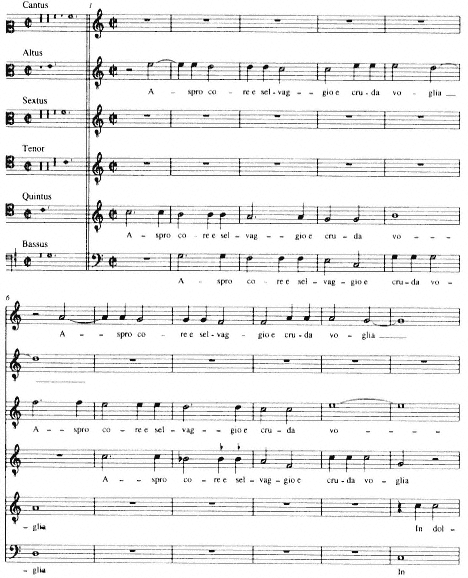
Ex. 16.
Willaert, Aspro core e selvaggio e cruda voglia (Petrarch, no. 265), mm. 1-22;
Musica nova (Venice, 1559), no. 14.
(continued on next page)
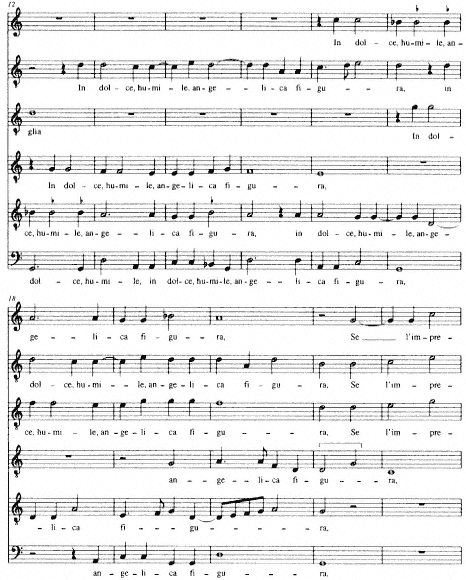
Ex. 16
(continued)
moves largely by melodic major seconds and major thirds and v. 2 by minor seconds and thirds and minor sixths, thus complementing the first verse's consonantal clusters and the liquids of the second (and recalling Zarlino's injunctions in Part IV, Chapter 32). Palisca also notes the tendency of the bass to move up by fifth and down by fourth for v. 1 and vice versa (down by fifth and up by fourth) for v. 2, tendencies Galilei associated with happiness, excitation, virility, and naturalness on the one hand and sad and subdued effects on the other.[61]
Willaert's interest in such dichotomies may seem clear in this instance, but it is rare that his Musica nova settings conform so straightforwardly to Bembist principles. Only three other cases, all again mainly notable for their exordia, are as striking in this respect as Aspro core. These include the pair of six-voice settings, I piansi, hor canto, che'l celeste lume and Cantai, hor piango, et non men di dolcezza ,[62] and the seven-voice Liete e pensose, accompagnate e sole.[63] Both of the first two begin with vivid antitheses that Willaert matched with madrigalisms: florid upturned melismas for singing and doleful sustained notes for weeping. In I piansi the image of weeping also invites a chain of suspensions (a virtual requirement at midcentury), here realized in varied entries of a stepwise descending motive alternating on arsis and thesis. (Quite unusually Willaert delayed the entrance of "hor canto" all the way until m. 9 and with it the establishment of the minim surface rhythm, which normally prevails after the first measure or two.)
The third setting that plays obviously with this sort of musical dialectic again embodies dualities codified by Bembo, especially in its octave.
"Liete e pensose, accompagnate e sole, "Happy and sad, in company and alone,
Donne che ragionando ite per via: Ladies who go talking by the way,
Ov'è la vita, ove la morte mia? Where is my life, my death?
Perché non è con voi com'ella sòle?" Why is she not with you as she is wont to be?" 4
"Liete siam per memoria di quel sole, "Happy are we in thinking of that sun;
Dogliose per sua dolce compagnia We are sad because we lack her company,
La qual ne toglie invidia et gelosia Which envious jealousy takes from us,
Che d'altrui ben quasi suo mal si dole." Grieving at another's good as if at its own harm." 8
[61] See Vincenzo Galilei, Dialogo della musica antica, et della moderna (Florence, 1581), p. 76.
[62] As in Petrarch's Canzoniere, the Musica nova places them side by side (though in reverse order). Discussions of this pair in the secondary literature can be found in Einstein, The Italian Madrigal 1:335-37; Willaert, Opera omnia 13:iv and v; Carapetyan, "The Musica nova of Adriano Willaert," pp. 164, 188, and 259-60; and Howard Mayer Brown, Music in the Renaissance (Englewood Cliffs, N.J., 1976), pp. 200-202. On Cantai, hor piango see also Bernhard Meier, "Rhetorical Aspects of Renaissance Modes," Journal of the Royal Musical Association 115 (1990): 183-84.
[63] Opera omnia 13:108-14. Liete e pensose is one of the two madrigals (along with Aspro core ) singled out by Mace for discussion ("The Literary Origins of the Italian Madrigal," pp. 80-83). Among the many other discussions of the madrigal are: Erich Hertzmann, Adrian Willaert in der weltlichen Vokalmusik seiner Zeit: Ein Beitrag zur Entwicklungsgeschichte der niederländisch-französischen und italienischen Liedformen in der ersten Hälfte des 16. Jahrhunderts (Leipzig, 1931), p. 53; Carapetyan, "The Musica nova of Adriano Willaert," pp. 118, 148, 185-86; Einstein, The Italian Madrigal 1:339; Willaert, Opera omnia 13:v; Helga Meier, "Zur Chronologie der Musica Nova Adriaen Willaerts," Analecta musicologica 12 (1973): 78; B. Meier, The Modes, pp. 126-28, 415; and David Alan Nutter, "The Italian Polyphonic Dialogue of the Sixteenth Century" (Ph.D. diss., University of Nottingham, 1978), 1:55.
These were lines ripe for the madrigalist's picking. Throughout the octave positive sentiments are keyed to the bright vowels e and i ("liete" and "vita," as well as the more neutral a , as in "accompagnate") and gloomier ones to the dark vowel o ("pen-sose," "sole," "morte," "dogliose"). Some of the contrasting terms are set in parallel structures that help tag rhythmically both meaning and sound: in v. I "liete" and "accompagnate" pair up as the first and corresponding terms in each syntactic entity and "pensose" and "sole" as the second — the second half of the verse thus echoing the first.
By articulating the syntactic inflections with rests and providing certain brightvoweled words with rising melodies and dark-voweled words with descending ones, Willaert intensified such parallelisms, as seen in Ex. 17. The four-voice group assigned to the first quatrain is divided into four sections, essentially one for each adjective. Willaert distinguished each through the contrast of major and minor intervals, both vertical and linear, in the uppermost voice: the major chords G and C and a melodic major second fall on "liete" and the minor chords a and d and a prominently accented melodic minor second, f to e, on "e pensose." Thereafter the "morte"/"vita" antithesis of v. 3 is expressed through similar means and further set off by parallel melodic motives in the altus — three repeated d's turning upward on "vita," downward on "morte."
Verse 5 summarizes the diverse syntactic and sentimental elements of the initial quatrain. By transferring to its outer limits both the words flanking v. 1 — "liete" and "sole" — Petrarch clarified their semantic relationship. The ladies' metaphoric recollection of Laura as that "sole," still resonating with its initial adjectival meaning, reminds the informed reader that she represents inseparably both happiness and loneliness. The new context of "liete" and "sole" in v. 5 thus enriches the words' meaning and consolidates them syntactically. As "Liete e pensose, accompagnate e sole" is recast as: "Liete siam per memoria di quel sole," that same "sole" which first conveyed desolation becomes, after the triple pun, a metaphor for the beloved who "sole" (both "alone" and "like the sun") in her radiance can produce happiness. Willaert's setting of v. 5 reflects this consolidation of symbol, syntax, and sense by delivering it in a single phrase, uninterrupted save short rests by cantus and sextus. It also reinterprets the final a-minor chord of v. 1's "sole" (m. 8) as A-major for that of v. 5 (m. 41). Moreover, the sextus and tenor, in mimicking the opening melodic material of septimus and altus, strengthen the correspondence between this verse and the first, helping to reinforce its special role in the octave.
I have touched on these four madrigals not only because all four trade in what are for Willaert uncommonly extroverted exordia, but because they have been the works most often cited from the Musica nova. In an important sense, they have formed the basis of widespread conceptions about Willaert's style. Their exemplary status in the musicological literature has lent support to certain representations of
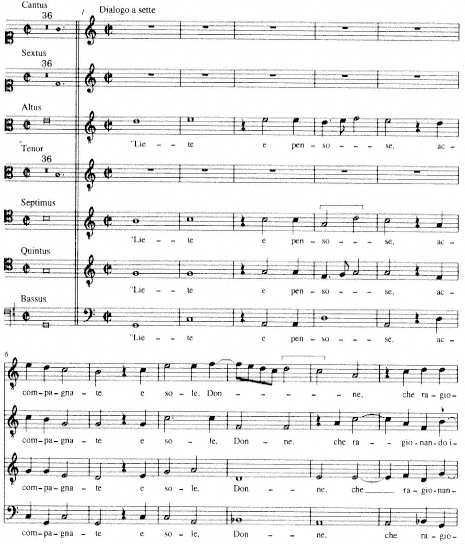
Ex. 17.
Willaert, Liete e pensose, accompagnate e sole (Petrarch, no. 222), mm. 1-42;
Musica nova (Venice, 1559), no. 23.
(continued on next page)
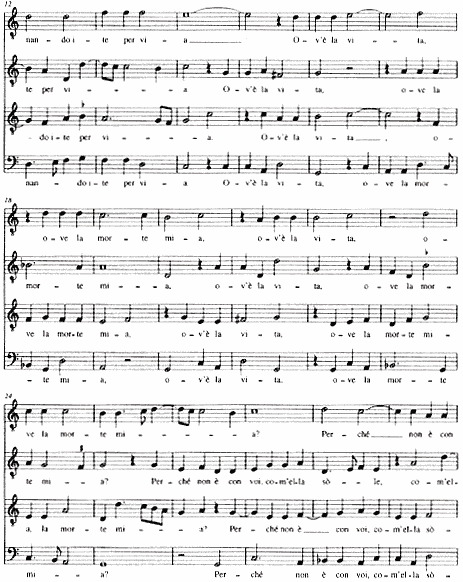
Ex. 17
(continued)
(continued on next page)
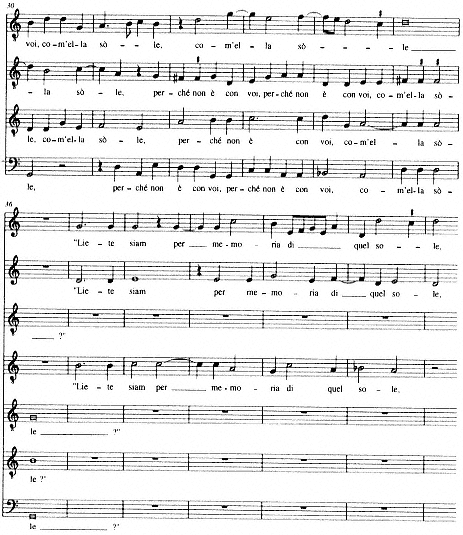
Ex. 17
(continued)
Willaert's new style as expressively vivid and given to musical symbolism, a representation first made by Gustave Reese. In asserting this, Reese isolated in the encyclopedic preserves of Music in the Renaissance only one tiny passage from the collection, a brief melisma on "cantando" from the otherwise archly spare Mentre che 'l cor.[64] His account of Musica nova style antedated the cross-disciplinary thinking that has since linked Willaert's madrigals to Bembo's ideas; it fell in better with teleological portrayals of madrigalian developments that sought to show the genre's increasing skill at mimesis over the course of the century. Like other such portrayals, a baldly mimetic approach seemed to offer the only tangible evidence of music's growing bond with words. It is not surprising that Reese had little else to say about the collection, since the reified textual-motivic links he wished to exemplify had in reality no prominent place in it.
Subsequent accounts have refined thinking about this repertory, yet something of the literalist impulse that guided Reese seems to underlie the expectations that have determined not only how we interpret but what we interpret — which examples have been chosen for close readings. Implicitly, at least, this literalism seems also to have shaped conceptions about the sorts of factors that must have governed Willaert's own readings, especially about how he realized Bembo's ideas: hence the censure, especially of Willaert's stark melody and undifferentiated pacing, that so often alloys praise of Willaert's late music, and the worrying over its lack of contrast.[65] Yet if, as I have insisted, strong juxtapositions were anathema to a Bembist idea of style, then Willaert's expressive reticence should cause neither surprise nor disappointment. I would view his subtly varied soggetti, plain rhythm, modest melody, and continuous musical fabric instead as carefully marshalled participants in his musica nova, a secular music intended to have no precedent or equal in weight and restraint. Willaert's personal conception — shared by his patrons, performers, and listeners — of the Musica nova as a monument to a newly conceived secular genre of the highest order seems clear from any number of features, both internal and external, that I have discussed: its compendious nature including four-, five-, six-, and seven-voice works, its mixing of madrigals with motets, its almost exclusive setting of Petrarch's poems, and its setting of complete sonnets.
Even those works by Willaert farthest from the Musica nova, his canzoni villanesche, seem to confirm the idea that his serious madrigals emerged from a
[64] Rev. ed. (New York, 1959), p. 324.
[65] See Edward E. Lowinsky, who suggests that humanistic demands for perfect declamation were the culprit hindering Willaert's ability to write good melodies: "Willaert's music has no easy appeal. Despite its masterly construction and notwithstanding its virtues of conciseness and elegance, its richness in harmonic color, its unexcelled adaption of the text, its variety of rhythmic and metric structure, it has a certain heaviness, hard to define, rooted perhaps in the absence of a true melodic inspiration. Yet the much freer flight of melody in his four-part ricercari suggests that the exigencies of a humanistically impeccable text setting in all the voices of a polyphonic complex of four, five, six, and more parts worked as a serious impediment to the free unfolding of melody" (Medici Codex 1:80). Similar reservations are voiced in Brown, "Words and Music," p. 228, and Carapetyan, "The Musica Nova of Adriano Willaert," pp. 115 and 147.
Bembist, hence Ciceronian, conception of stylistic propriety.[66] His conscious sense of purpose is evident from the way he codified the lighter style and segregated it (with help from Venetian printers) in separate publications. Indeed, the wholesale bifurcation of secular music into discrete genres, high and low, in Venetian musical production of the 1540s provides one of the clearest signs that Willaert's decorous fashioning of the madrigal was no failure of inspiration but one of the most concerted acts of Ciceronianism to emerge from early modern Venice.[67]
[66] The point is mentioned in Brown ("Words and Music," p. 229), who suggests that diverse genres in the music of Willaert and his students reflected Bembo's classical advocation of different stylistic levels. See also James Haar, who discusses the concern for genre in the period of Bembo's influence in Essays on Italian Poetry and Music in the Renaissance, 1350-1600 (Berkeley and Los Angeles, 1986), pp. 117-18; and idem, "Self-Consciousness about Style, Form, and Genre in 16th-Century Music," Studi musicali 3 (1974): 219-31; and Nino Pirrotta, "Willaert and the Canzone Villanesca ," in Music and Culture in Italy from the Middle Ages to the Baroque: A Collection of Essays (Cambridge, Mass., 1984); p. 179.
[67] The argument laid out in Michèle Fromson's "Themes of Exile in Willaert's Musica nova, " JAMS 47 (1994): 442-87, first came to my attention as this book was in press. Fromson's study contributes to our understanding of the religious background of Florentine republicans but reduces the multivalent cultural geography in which the Musica nova evolved to a single Florentine solution, reading the print's motet and Petrarchan sonnet texts as having registered solely in Florentine terms. I perceive a Florentine accent in Rore's first book but much less of one in Willaert's Musica nova, and I would question whether the romantic narrative of "heroic struggle" and "suicide" (pp. 465-66) that Fromson imposes on Florentine exiles (cf. p. 29 above) can be readily made to fit Neri Capponi, who is in fact the only known Florentine patron of the print. The crucial evidentiary basis of Fromson's thesis is the claim that Willaert's motets and madrigals evoked the Florentines' situation by quoting chants linked to loss and exile, but it is useful to remember here that Willaert's whole modal-melodic language was chant-based and that his melodic style in any case avoided distinctive motives.